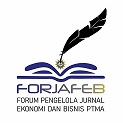Analisis Variabel Sosial Ekonomi Terhadap Kemiskinan di Indonesia
Abstract
Indonesia's poverty condition in March 2019 recorded at 9.41 percent. Supposedly, Indonesia reaches the RPJMN target where the poverty level is planned at a 7-8 percent level. The High levels of rural poverty compared to urban areas exceeded the percentage of national poverty. Low wages are also an indication that the problem of poverty occurs continuously. The purpose of this research is to know how socio-economic variables such as human development, unemployment, wage, and inequality can affect poverty reduction in Indonesia. This research uses secondary data obtained from the website of Statistics Indonesia (BPS) and the Databoks Katadata website. This study uses cross-section data with 34 provincial observations in the year 2019. This research used econometric methodologies with the regression of Ordinary Least Square as an analysis tool. This research show that poverty in Indonesia is still very dominant in the island of Papua, in the provinces of Papua and West Papua and in the island of Nusa Tenggara, in the provinces of West Nusa Tenggara and East Nusa Tenggara. Human development has a negative effect where every human development increase by 1 percent will reduce poverty in Indonesia by 5.69 percent. The declining unemployment rate has contributed to poverty reduction in Indonesia by 0.34 percent. Wages, in this case, can reduce poverty. Increasing wages by 1 percent can reduce poverty by 1.08 percent and vice versa. Reducing inequality by 1 percent can reduce poverty by up to 1.88 percent.
Keywords: poverty, HDI, unemployment, wage, inequality
Full Text:
PDFReferences
Amaluddin, Payapo, R. W., Laitupa, A. A., & Serang, M. R. (2018). International Journal of Economics and Financial Issues A Modified Human Development Index and Poverty in the Villages of West Seram Regency, Maluku Province, Indonesia. International Journal of Economics and Financial Issues, 8(2), 325–330.
Anjaeni, R. (2020). Enam Faktor yang Mempengaruhi Tingkat Kemiskinan Versi BPS. Retrieved April 7, 2020, from nasional.kontan.co.id website: https://nasional.kontan.co.id/news/enam-faktor-yang-mempengaruhi-tingkat-kemiskinan-versi-bps
Arimah, B. (2004). Poverty Reduction and Human Development in Africa. Journal of Human Development, 5(3), 399–415. https://doi.org/10.1080/1464988042000277260
Aryani, D. S., & Rachmawati, Y. (2019). Tipologi Kemiskinan di Kota Palembang dengan Menggunakan Model Cibest. Jurnal Ilmiah Ekonomi Global Masa Kini, 10(2), 93–98. Retrieved from http://ejournal.uigm.ac.id/index.php/EGMK/article/view/844
Bappenas. (2017). Evaluasi Paruh Waktu RPJMN 2015-2019. Retrieved from https://www.bappenas.go.id/id/berita-dan-siaran-pers/evaluasi-paruh-waktu-rpjmn-2015-2019/
Fosu, A. K. (2007). Poverty and development. Bulletin of the World Health Organization, 85(10), 733–820. Retrieved from https://www.who.int/bulletin/volumes/85/10/07-045955/en/
Fosu, A. K. (2017). Growth, inequality, and Poverty Reduction in Developing Countries: Recent Global Evidence. Research in Economics, 71(2), 306–336. https://doi.org/10.1016/j.rie.2016.05.005
Gindling, T. (2014). Does Increasing The Minimum Wage Reduce Poverty in Developing Countries? IZA World of Labor, 30(May), 1–10. https://doi.org/10.15185/izawol.30
Ginting, A. M. (2015). The Influence of Regional Disparity on Poverty in Indonesia During 2004-2013. Jurnal Ekonomi Pembangunan, 20(1), 45–58.
Gujarati, D. N., & Porter, D. C. (2009). Basic of Econometric. In Econometrics (Fifth). https://doi.org/10.1007/978-1-137-37502-5_17
Gunawan, I. (2017). Pengantar Statistika Inferensial (Pertama). Jakarta: Rajawali Pers.
Infid. (2015). Sustainable Development Goals. Retrieved March 27, 2020, from International NGO Forum on Indonesian Development website: https://www.sdg2030indonesia.org/#modalIconDefinition
Jayani, D. H. (2020). Upah Buruh Tani 2019 Menurun. Retrieved March 30, 2020, from katadata.co.id website: https://databoks.katadata.co.id/datapublish/2020/01/20/upah-buruh-tani-2019-menurun
Kurniawati, A., Gunawan, B. T., & Indrasari, D. P. R. (2017). Dampak Upah Minimum Terhadap Kemiskinan Di Indonesia Tahun 2006-2014. Jurnal Riset Ekonomi Dan Manajemen, 17(2), 233. https://doi.org/10.17970/jrem.17.170207.id
Mackie, E. (2012). Understanding Poverty: The Human Development Approach (pp. 1–6). pp. 1–6. Retrieved from http://www.e-ir.info/2012/04/17/understanding-poverty-the-human-development-approach/
Mohammad, U. F., & David, J. (2019). The Relationship between Poverty and Unemployment in Niger State. Signifikan: Jurnal Ilmu Ekonomi, 8(1), 71–78. https://doi.org/10.15408/sjie.v8i1.6725
Pebrianto, F. (2019). Indef: Pengentasan Kemiskinan Era Jokowi Tak Capai Target RPJMN. Retrieved March 30, 2020, from bisnis.tempo.co website: https://bisnis.tempo.co/read/1225177/indef-pengentasan-kemiskinan-era-jokowi-tak-capai-target-rpjmn/full&view=ok
Pusparisa, Y. (2019). Jumlah Penduduk Miskin di Desa dan Kota Mengalami Penurunan. Retrieved March 30, 2020, from katadata.co.id website: https://databoks.katadata.co.id/datapublish/2019/12/20/jumlah-penduduk-miskin-di-desa-dan-kota-mengalami-penurunan
Ramdhani, D. (2019). Pemberdayaan Penduduk dalam Kemiskinan Pedesaan. Retrieved March 30, 2020, from www.ayobandung.com website: https://www.ayobandung.com/read/2019/08/20/61140/pemberdayaan-penduduk-dalam-kemiskinan-pedesaan
Ritonga, R. (2015). Kemiskinan dan Pembangunan Manusia. Retrieved March 30, 2020, from mediaindonesia.com website: https://mediaindonesia.com/read/detail/1241-kemiskinan-dan-pembangunan-manusia
Rohima, S., Suman, A., Manzilati, A., & Ashar, K. (2013). Vicious Circle Analysis of Poverty and Entrepreneurship. IOSR Journal of Business and Management, 7(1), 33–46. https://doi.org/10.9790/487x-0713346
Sedana, Y. I. M. S., Sri, B. M. K., Djinar, S. N., & Nyoman, S. I. A. (2019). Socio-Economic Factors Affecting Poverty in Bali Province, Indonesia. Russian Journal of Agricultural and Socio-Economic Sciences, 90(6), 192–202. https://doi.org/10.18551/rjoas.2019-06.25
Setiaji, H. (2019). Pantesan RI Terancam Krisis Petani, Upah Kecil & Miskin Terus. Retrieved March 30, 2020, from cnbcindonesia.com website: https://www.cnbcindonesia.com/news/20191115141634-4-115591/pantesan-ri-terancam-krisis-petani-upah-kecil-miskin-terus
Setiaji, H. (2020). Ini yang Bikin Orang Miskin di RI Susah “Naik Kelas.” Retrieved March 30, 2020, from cnbcindonesia.com website: https://www.cnbcindonesia.com/news/20200203151826-4-134832/ini-yang-bikin-orang-miskin-di-ri-susah-naik-kelas
Siyan, P., Adegoriola, A. E., & Adolphus, J. A. (2016). Munich Personal RePEc Archive Unemployment and Inflation: Implication on Poverty Level in Nigeria. In Munich Personal RePEc Archive. Retrieved from https://mpra.ub.uni-muenchen.de/79765/1/MPRA_paper_79765.pdf
Statistik, B. P. (2019). Persentase Penduduk Miskin Maret 2019 Sebesar 9,41 Persen. Retrieved March 27, 2020, from BPS - Statistics Indonesia website: https://www.bps.go.id/pressrelease/2019/07/15/1629/persentase-penduduk-miskin-maret-2019-sebesar-9-41-persen.html
Statistik, B. P. (2020). Kemiskinan dan Penduduk Miskin. Retrieved March 30, 2020, from bps.go.id website: https://www.bps.go.id/subject/23/kemiskinan-dan-ketimpangan.html#subjekViewTab1
Subanidja, S., & Suharto, E. (2014). The Dominant Factors in The Causes of Proverty Level in Indonesia. Humanity and Social Sciences Review, 3(1), 67–76.
Syofya, H. (2018). Effect of Poverty and Economic Growth on Indonesia Human Development Index. Jurnal Ilmiah Universitas Batanghari Jambi, 18(2), 416–423. https://doi.org/DOI: 10.33087/jiubj.v18i2.486
Wijayanto, A. T. (2016). Analisis Keterkaitan Pertumbuhan Ekonomi, Ketimpangan Pendapatan Dan Pengentasan Kemiskinan Di Provinsi Sulawesi Utara Tahun 2000-2010. Jurnal Berkala Ilmiah Efisiensi, 16(2), 418–428.
World Bank. (2019). Tingkat Kemiskinan dan Rentan Kemiskinan di Indonesia Tertinggi Ada di Perdesaan. Retrieved April 9, 2020, from katadata.co.id website: https://databoks.katadata.co.id/datapublish/2019/10/08/tingkat-kemiskinan-dan-rentan-kemiskinan-di-indonesia-tertinggi-ada-di-perdesaan
DOI: https://doi.org/10.24269/iso.v5i1.636
Refbacks
- There are currently no refbacks.

This work is licensed under a Creative Commons Attribution 4.0 International License








.jpg)


.png)


